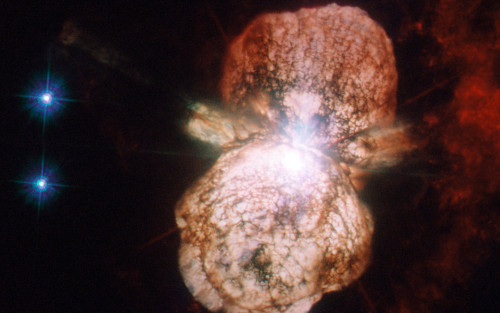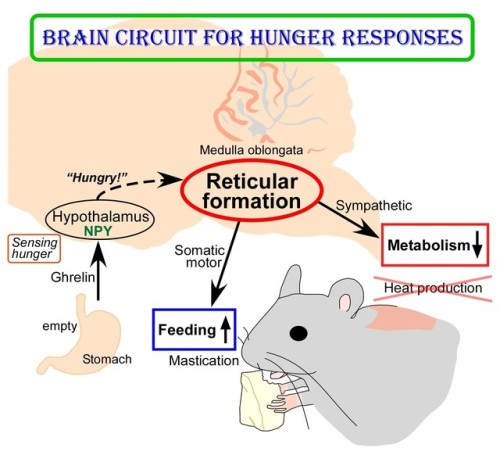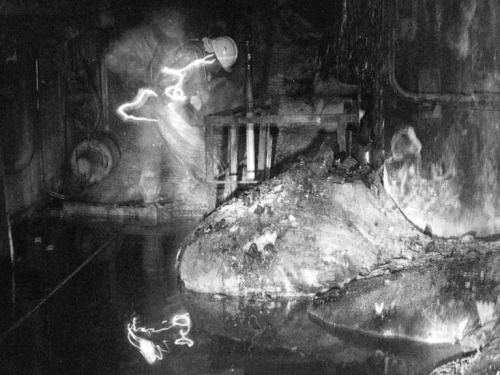Oh Hey, Not A Big Deal, But The Hubble Took A picture of A Star That’s Nearing supernova Status

Oh hey, not a big deal, but the hubble took a picture of a star that’s nearing supernova status
More Posts from Science-is-magical and Others

(Image caption: The empty stomach releases the hormone called ghrelin. By receiving ghrelin, the hypothalamus in the brain senses hunger and produces “hunger signaling” through the action of neuropeptide Y (NPY). The hunger signaling activates neurons in the reticular formation of the medulla oblongata, which then inhibit sympathetic output to reduce metabolic heat production and simultaneously provide masticatory motor rhythm to facilitate feeding. Credit: © 2017 Yoshiko Nakamura)
New Insights into Brain Circuit for Hunger Responses during Starvation
The human body responds to starving conditions, such as famine, to promote the chance of survival. It reduces energy expenditure by stopping heat production and promotes feeding behavior. These “hunger responses” are activated by the feeling of hunger in the stomach and are controlled by neuropeptide Y (NPY) signals released by neurons in the hypothalamus. However, how NPY signaling in the hypothalamus elicits the hunger responses has remained unknown.
Sympathetic motor neurons in the medulla oblongata are responsible for heat production by brown adipose tissue (BAT). Researchers centered at Nagoya University have now tested whether the heat-producing neurons respond to the same hypothalamic NPY signals that control hunger responses. They injected NPY into the hypothalamus of rats and tested the effect on heat production. Under normal conditions, blocking inhibitory GABAergic receptors or stimulating excitatory glutamatergic receptors in the sympathetic motor neurons induced heat production in BAT. After NPY injection, stimulating glutamatergic receptors did not produce heat, but inhibiting GABAergic receptors did. The study was reported in Cell Metabolism.
“This indicated that hypothalamic NPY signals prevent BAT thermogenesis by using inhibitory GABAergic inputs to sympathetic motor neurons,” study lead author Yoshiko Nakamura says.
Retrograde and anterograde tracing with fluorescent dyes revealed which brain region provided the inhibitory GABAergic inputs to heat-producing motor neurons.
“Tracing experiments showed that sympathetic motor neurons are directly innervated by GABAergic inputs from reticular nuclei in the medulla oblongata,” corresponding author Kazuhiro Nakamura explains, “selective activation of these GABAergic reticular neurons inhibits BAT thermogenesis.”
The researchers’ further findings showed that GABAergic inputs from medullary reticular neurons are involved in hypothalamic NPY-mediated inhibition of heat production in BAT. This hunger response circuit probably explains why anorexic individuals suffer from hypothermia.
Interestingly, stimulation of these medullary reticular neurons prompted rats to begin chewing and feeding. This effect was similar to injecting NPY into the hypothalamus, suggesting that hypothalamic NPY signaling activates reticular neurons in the medulla oblongata to promote feeding and mastication during the hunger response.
Abnormal activation of these neurons under non-starved conditions may contribute to obesity. Understanding these mechanisms could lead to development of more effective treatments for obesity.
This is the chemical formula for love: C8H11NO2+C10H12N2O+C43H66N12O12S2 dopamine, seratonin, oxytocin. It can be easily manufactured in a lab, but overdosing on any of them can cause schizophrenia, extreme paranoia, and insanity. Let that sink in.
(via mrzim)

The folks over at NASA just featured this nifty infographic on APOD about detecting objects in the sky:
How to Identify that Light in the Sky
What is that light in the sky?
Perhaps one of humanity’s more common questions, an answer may result from a few quick observations.
Image: HK (The League of Lost Causes)
For example — is it moving or blinking? If so, and if you live near a city, the answer is typically an airplane, since planes are so numerous and so few stars and satellites are bright enough to be seen over the din of artificial city lights.
If not, and if you live far from a city, that bright light is likely a planet such as Venus or Mars — the former of which is constrained to appear near the horizon just before dawn or after dusk.
Sometimes the low apparent motion of a distant airplane near the horizon makes it hard to tell from a bright planet, but even this can usually be discerned by the plane’s motion over a few minutes. Still unsure?
The above chart gives a sometimes-humorous but mostly-accurate assessment. Dedicated sky enthusiasts will likely note — and are encouraged to provide — polite corrections.


One of the most dangerous pictures ever taken - Elephant’s Foot, Chernobyl. This is a photo of a now dead man next the ‘Elephant’ Foot’ at the Chernobyl power plant.
The image distortions in the photo are created by intense level of radiation almost beyond comprehension. There is no way the person in this photo and the person photographing him could have survived for any more that a few years after being there, even if they quickly ran in, took the photos and ran out again. This photo would be impossible to take today as the rates of radioactive decay are even more extreme now due to a failed military experiment to bomb the reactor core with neuron absorbers. The foot is made up of a small percentage of uranium with the bulk mostly melted sand, concrete and other materials which the molten corium turns into a kind of lava flow. In recent years, it has destroyed a robot which tried to approach it, and the last photos were taken via a mirror mounted to a pole held at the other end of the corridor for a few seconds. It is almost certainly the most dangerous and unstable creation made by humans. These are the effects of exposure: 30 seconds of exposure - dizziness and fatigue a week later 2 minutes of exposure - cells begin to hemorrhage (ruptured blood vessels) 4 minutes - vomiting, diarrhea, and fever 300 seconds - two days to live
-
 pagaiduvariants reblogged this · 3 months ago
pagaiduvariants reblogged this · 3 months ago -
 5thplanetemmerich reblogged this · 1 year ago
5thplanetemmerich reblogged this · 1 year ago -
 1doppelganger1 reblogged this · 1 year ago
1doppelganger1 reblogged this · 1 year ago -
 dorsilasol reblogged this · 1 year ago
dorsilasol reblogged this · 1 year ago -
 littlemouserat reblogged this · 2 years ago
littlemouserat reblogged this · 2 years ago -
 astralwashboard reblogged this · 2 years ago
astralwashboard reblogged this · 2 years ago -
 rachel-wayward liked this · 2 years ago
rachel-wayward liked this · 2 years ago -
 crazygingerwitch reblogged this · 2 years ago
crazygingerwitch reblogged this · 2 years ago -
 dirkada liked this · 2 years ago
dirkada liked this · 2 years ago -
 littlemouserat liked this · 2 years ago
littlemouserat liked this · 2 years ago -
 leezardweezard liked this · 2 years ago
leezardweezard liked this · 2 years ago -
 the-local-gremlin reblogged this · 2 years ago
the-local-gremlin reblogged this · 2 years ago -
 astralwashboard reblogged this · 2 years ago
astralwashboard reblogged this · 2 years ago -
 lunaroceanic reblogged this · 2 years ago
lunaroceanic reblogged this · 2 years ago -
 lunaroceanic liked this · 2 years ago
lunaroceanic liked this · 2 years ago -
 paperhatsandrabbits reblogged this · 2 years ago
paperhatsandrabbits reblogged this · 2 years ago -
 paperhatsandrabbits liked this · 2 years ago
paperhatsandrabbits liked this · 2 years ago -
 foxy-disaster liked this · 2 years ago
foxy-disaster liked this · 2 years ago -
 krockat liked this · 2 years ago
krockat liked this · 2 years ago -
 sp1ne-sh0t reblogged this · 2 years ago
sp1ne-sh0t reblogged this · 2 years ago -
 sp1ne-sh0t liked this · 2 years ago
sp1ne-sh0t liked this · 2 years ago -
 cipherbunz liked this · 2 years ago
cipherbunz liked this · 2 years ago -
 extremelycompressedjpeg reblogged this · 2 years ago
extremelycompressedjpeg reblogged this · 2 years ago -
 shortguyswag liked this · 2 years ago
shortguyswag liked this · 2 years ago -
 kymothy liked this · 2 years ago
kymothy liked this · 2 years ago -
 chaosnatural reblogged this · 2 years ago
chaosnatural reblogged this · 2 years ago -
 tiredwlw reblogged this · 2 years ago
tiredwlw reblogged this · 2 years ago -
 willshaper reblogged this · 2 years ago
willshaper reblogged this · 2 years ago -
 willshaper liked this · 2 years ago
willshaper liked this · 2 years ago -
 buttfacemcgee reblogged this · 2 years ago
buttfacemcgee reblogged this · 2 years ago -
 cool-gemini liked this · 2 years ago
cool-gemini liked this · 2 years ago -
 raccoonwithadream reblogged this · 2 years ago
raccoonwithadream reblogged this · 2 years ago -
 raccoonwithadream liked this · 2 years ago
raccoonwithadream liked this · 2 years ago -
 transmascdipper reblogged this · 2 years ago
transmascdipper reblogged this · 2 years ago -
 lastdovahkiin reblogged this · 2 years ago
lastdovahkiin reblogged this · 2 years ago -
 the-gayest-dovah reblogged this · 2 years ago
the-gayest-dovah reblogged this · 2 years ago -
 the-gayest-dovah liked this · 2 years ago
the-gayest-dovah liked this · 2 years ago -
 bumblebearcompany reblogged this · 2 years ago
bumblebearcompany reblogged this · 2 years ago -
 chameleoneon reblogged this · 2 years ago
chameleoneon reblogged this · 2 years ago -
 chameleoneon liked this · 2 years ago
chameleoneon liked this · 2 years ago -
 littlenightwing reblogged this · 2 years ago
littlenightwing reblogged this · 2 years ago -
 littlenightwing liked this · 2 years ago
littlenightwing liked this · 2 years ago -
 ceterisgalaxy reblogged this · 2 years ago
ceterisgalaxy reblogged this · 2 years ago -
 kitchensinksurrealism liked this · 3 years ago
kitchensinksurrealism liked this · 3 years ago -
 doestheskyforget reblogged this · 3 years ago
doestheskyforget reblogged this · 3 years ago -
 aidywong liked this · 4 years ago
aidywong liked this · 4 years ago





![Source [x]](https://64.media.tumblr.com/c67e16b83f88fe48da4656147229f385/tumblr_nz90mw4OiA1u1i4d4o1_500.jpg)
![Source [x]](https://64.media.tumblr.com/a60c74bcd55fb8555c574abb6eb4a0aa/tumblr_nz90mw4OiA1u1i4d4o2_500.jpg)
![Source [x]](https://64.media.tumblr.com/35e92a53a2e18de1283034cd6d7999ea/tumblr_nz90mw4OiA1u1i4d4o3_500.jpg)
![Source [x]](https://64.media.tumblr.com/4c1566aefd626f49bf3bfaf0c2e04616/tumblr_nz90mw4OiA1u1i4d4o4_500.jpg)
![Source [x]](https://64.media.tumblr.com/61c3673d595a1d1ddb2bd9c6d25862ae/tumblr_nz90mw4OiA1u1i4d4o5_500.jpg)
![Source [x]](https://64.media.tumblr.com/3830b9a2ede2b1021bb8596b1bc4bb6f/tumblr_nz90mw4OiA1u1i4d4o6_500.jpg)